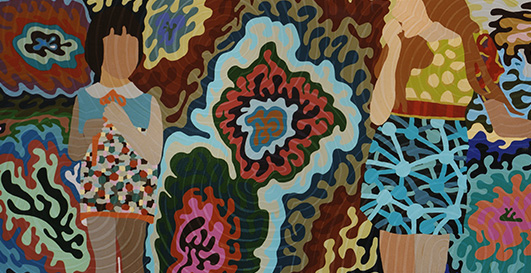
Lebenglik

Carolina Antoniadis’ Painting could be seen as a materialist and optical version of that much repeated phrase of Le Petit Prince according to which essential things are invisible and hence cannot be recorded by the eye. In this case, what is essential is optimally perceptible or she undertakes to make it visible. The world painted by the artist is a collection of images supplied by multiple and varied sources, cultures and times. Her work apparently – the sense of appearance is inherent to her production – moves between surface and color.
It is a modern and mannerist painting, full of interwoven images, in which the entire painted surface, each centimeter of it, relates to, quotes or refers us to some term of that encyclopedia.
In this regard, the decorative and “superficial” quality, on account of its excess, abandons the hypothesis of being a visual accompaniment and turns into core and center, since the so-called reality is essentially visible. This makes the surface relevant, coinciding in its foundations with Chomsky’s theory according to which it is possible to trace all the operations leading to the present aspect of language on account of the presence of a number of components and even by the tracks left by the absence of others.
In this surfaces game, tapestry is one of the crafts and industrial traditions more often quoted in Antoniadis’ painting.
Fabrics, textures and garments of all kind parade through her pictures.
The absence of perspective, the plane vision of her pictures is combined with a continued fragmentation of the image and the planes.
This fragmentary quality functions as a composition resource and constructive principle.
Each picture becomes an image-devouring device.
The plurality of quotations, the textures, the forms and colors juxtaposition and interweaving become a voracious mechanism of incorporation of multiple figurations. Vertigo is added to the voraciousness of the “system”.
The ornamental procedures, which, in a first approach, would seek harmony between colors and forms, show here a joyous bonus: they juxtapose with humor and irony.
Antoniadis uses the keys of a standardized and conventional decorative esthetics, as is textile printing, and molds them parodically through a complex baroque of visual surfaces and textures.
Her images start by describing a dailiness which, by the components’ contrast, enumeration and complementation becomes ideological since sense is given by accumulation and contiguity.
With delicate lucidity, Antoniadis combines esthetic knowledge with daily and intimate knowledge. There also exists a place for intimacy (though modest) in her work, almost like a personal diary written in code.
